2001 Kawasaki Lakota Sport Hop-up Series
| Lakota Sport Modifications, Part 5 Rear Tires & Weight |
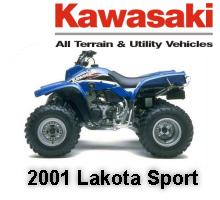 |
 After the rear brake upgrade it became apparent the Goodyear Wrangler Sport rear tires were not up to the task. In choosing a rear tire replacement, we wanted a tire that would not overcome the engines capability, yet increase traction. We also did not want to sacrifice ride comfort. At the Indianapolis Powersports Show in Feb. I talked to Titan tire about this project and they suggested we give their new upgraded 489 tire called the 489X/T. This tire had a very aggressive tread pattern and was rated at 6ply. I was concerned about the ride quality, but they assured me that because of the way the tread plies were laid down and the tread pattern, this tire would ride quite smooth. As soon as they became available, we were sent a pair in 22x11x10. Initial impressions of
After the rear brake upgrade it became apparent the Goodyear Wrangler Sport rear tires were not up to the task. In choosing a rear tire replacement, we wanted a tire that would not overcome the engines capability, yet increase traction. We also did not want to sacrifice ride comfort. At the Indianapolis Powersports Show in Feb. I talked to Titan tire about this project and they suggested we give their new upgraded 489 tire called the 489X/T. This tire had a very aggressive tread pattern and was rated at 6ply. I was concerned about the ride quality, but they assured me that because of the way the tread plies were laid down and the tread pattern, this tire would ride quite smooth. As soon as they became available, we were sent a pair in 22x11x10. Initial impressions of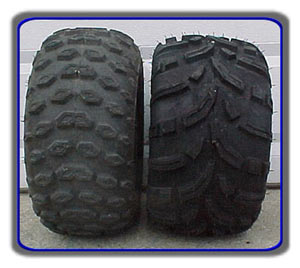 the unmounted tires were that the X/T’s are a flatter profile, slightly shorter, and have a much more aggressive tread pattern than the OEM Goodyear Wrangler Sports. These were then mounted on the stock factory rims.
the unmounted tires were that the X/T’s are a flatter profile, slightly shorter, and have a much more aggressive tread pattern than the OEM Goodyear Wrangler Sports. These were then mounted on the stock factory rims. 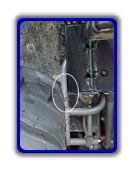 Mounting was uneventful. The stiffer sidewalls of the X/T’s made bead seating a breeze. Immediately after placing the rims on the rear axle, we noticed the X/T’s additional width was quite close to the battery box.
Mounting was uneventful. The stiffer sidewalls of the X/T’s made bead seating a breeze. Immediately after placing the rims on the rear axle, we noticed the X/T’s additional width was quite close to the battery box.
We set the initial tire pressure at 3 psi and headed out to see what we had. The ride was indeed smooth and the traction was much improved. Now the power of the redesigned brake linkage could be utilized to its fullest. This machine finally stops! The X/T’s even held a neutral slide! Wish we had some mud to test the traction abilities however with the hot dry summer we were having, we would have to wait until fall for the Newton Falls Poker Run to really test the capabilities of these tires. In the mean time we decided to try and reduce the weight of the Lakota Sport because at 459lbs, it could surely stand to loose a few pounds.
We contacted DG Performance for an aluminum skid plate to replace the flimsy stock steel unit with one of their Baja units. It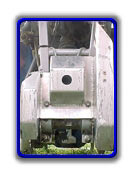
did not bolt up however without some persuasion. It is possible our swingarm is slightly out after many miles of testing (getting bashed!). The increased protection over the steel factory unit was immense.
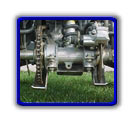
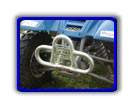 Next on our list of must-haves was a better front bumper. We have always liked the design and strength of the DG aluminum
Next on our list of must-haves was a better front bumper. We have always liked the design and strength of the DG aluminumbumpers. The lower loops provide the perfect handholds for lifting the machine out of an Oh-My-God! The factory provides you with nothing horizontal to grab hold of. This unit was designed for the Kawasaki Mojave. The only change needed to mount the Mojave unit on the Lakota is to not use the provided spacer blocks in the aluminum Next on our list of must-haves was a better front bumper. We have always liked the
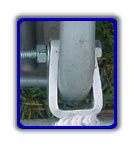 design and strength of the DG aluminumclamps. The Lakota frame uses smaller diameter tubing and without the spacer blocks you can squeeze the clamps tighter together so the bumper is solidly mounted.
design and strength of the DG aluminumclamps. The Lakota frame uses smaller diameter tubing and without the spacer blocks you can squeeze the clamps tighter together so the bumper is solidly mounted. the factory steel rims onthe right.
the factory steel rims onthe right.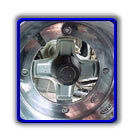 reaming the holes 1/32in in an effort to ease installation because as delivered this was as far as we could slide them on.
reaming the holes 1/32in in an effort to ease installation because as delivered this was as far as we could slide them on.
So, how did the Lakota fare on its diet? Not too well actually. As you can see below, we lost big time with the exhaust. But then gained 2lbs back with the Goodyear Tracker tires over the Wrangler Sports. However the steering and braking improvement was worth the trade off. Same for the rear. We gained an additional 4 lbs but also picked up a bucket load of traction. Going to the aluminum rims dropped the Lakota another 12lbs. So even with bigger, better, heavier tires, the use of aluminum rims gave us a net loss of 6lbs.
The aluminum DG swingarm skid plate was actually heavier than the factory steel unit primarily because the factory unit is flimsy for serious conditions and the DG unit gives full serious coverage. And we gained another 3lbs with the DG front bumper because the only thing resembling a front bumper on the Lakota is the twin rubber bumper pads on the front of the frame. The most important weight on any ATV is its unsprung weight and rolling mass. Thankfully both were reduced with this diet regimen.
| FACTORY ITEM | WEIGHT | AFTERMARKET ITEM | WEIGHT | LOSS/GAIN |
| OEM Exhaust | 10lbs. | Supertrapp IDS 2 Exhaust | 4lbs. | -7lbs.* |
| Goodyear Wrangler Sport 22x8x10 | 11lbs. | Goodyear Tracker ST 23x7x10 | 12lbs. | +2lbs. |
| Goodyear Wrangler Sport 22x11x10 | 17lbs. | Titan 489 X/T 22x11x10 | 19lbs | +4lbs. |
| Front Steel Rims | 6lbs. | ITP Aluminum Rim | 4lbs. | -4lbs. |
| Rear Steel Rims | 9lbs. | ITP Aluminum Rim | 5lbs. | -8lbs. |
| Front Rubber Bumpers | 1lb. | DG Aluminum Front Bumper | 4lbs. | +3lbs. |
| Steel Swingarm Skid Plate | 3lbs. | DG Aluminum Swingarm Skid Plate | 4lbs. | +1lb. |
| Total weight reduction: |
-9lbs. | |||
| * The difference was 6lbs. but when you add in the unused brackets, you gain another pound. |
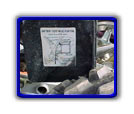 the stock rims we must be riding harder with the reduced rolling mass and deflecting the left rear tire in slides into the battery box. At this time it does not look like there will be any lasting damage to either the battery box or the tire. It appears to be strictly a visual thing.
the stock rims we must be riding harder with the reduced rolling mass and deflecting the left rear tire in slides into the battery box. At this time it does not look like there will be any lasting damage to either the battery box or the tire. It appears to be strictly a visual thing. Finally Fall arrived and the dreaded Newton Falls Poker Run. Here we could finally test the tires in true mud conditions. This years mud was sticky because of the lack of rain all summer.
Unfortunately some of that mud made its way into my camera and all of the digital images from that ride are bad except for the last one when we got back to the ATV Connection North shop! I can tell you that as long as the Lakota didn’t “case out”on a hidden rock, the Titan X/T’s got us through. Even when we got stuck, the tires allowed us to back out of that situation. This is unusual for a 2-wheel drive ATV. Once you get yourself in, you most usually can’t back out! We did this on more than one occasion. The Lakota was one of the few 2-wheel drive ATV’s to make it through that day. Most everybody rides Newton Falls on 4×4 Utility Quads.
the last one when we got back to the ATV Connection North shop! I can tell you that as long as the Lakota didn’t “case out”on a hidden rock, the Titan X/T’s got us through. Even when we got stuck, the tires allowed us to back out of that situation. This is unusual for a 2-wheel drive ATV. Once you get yourself in, you most usually can’t back out! We did this on more than one occasion. The Lakota was one of the few 2-wheel drive ATV’s to make it through that day. Most everybody rides Newton Falls on 4×4 Utility Quads.
Part of this situation was due to the wide profile and aggressive tread design. Part was due to the motor (all mods enhanced mid-top), and part was due to raising the gearing 1 tooth on the countershaft sprocket. In retrospect, stock gearing may have been better suited to the severe conditions of a typical Newton Falls run. However the decision at the time was to run it as it stood without any special preparation, because that is what the average owner would do. And except for that one occasion, it managed quite well.
In the sand dune section of the poker run, we found the traction to be adequate. While the tires were not designed to hold a slide across the face of a dune, (and the motor didn’t have the power) we certainly weren’t going to get stuck either. We could traverse the dunes and climb any ridge, just a bit slower and not quite as sporty as a true high performance 4-stroke ATV.
slide across the face of a dune, (and the motor didn’t have the power) we certainly weren’t going to get stuck either. We could traverse the dunes and climb any ridge, just a bit slower and not quite as sporty as a true high performance 4-stroke ATV.
We flew editors in to evaluate this quad from all corners of the country. Our Outdoors Editor loved to wheelie the Lakota. Our Dunes Editor liked it too saying it was cool. Our publisher thought it was snappy. Both our Outdoors and Dunes editors wished for a bit more low-end power. Again, part of this feeling of lethargic power output at low RPMs is due to the taller gearing. The +1 countershaft sprocket was chosen because it livened up the mid through top-end power and allowed the motor to accelerate the chassis faster, given the fact the utility-based engine could only rev so fast no matter what performance changes were done to it.. And the taller gearing produced a substantial top speed (+1.4mph) increase. For average trail riding, we feel you would be above low-end and be running mostly in the mid-range, where the Connection modified utility-based motor shines. So go and have fun with your “little” Lakota Sport. We did!
